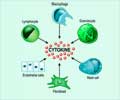When the alert goes out that a virus has invaded the body, cells that have yet to be attacked prepare by "armoring" themselves for combat, attaching specific antiviral molecules
When the alert goes out that a virus has invaded the body, cells that have yet to be attacked prepare by "armoring" themselves for combat, attaching specific antiviral molecules to many of their own proteins to help resist the invader.
These antiviral molecules aren't literally armor — the virus won't physically beat on them. But scientists believe adding these molecules to cellular proteins, like putting on armor, changes the proteins in ways that make the cells resistant to the coming viral attack.Unfortunately, the deadly Crimean Congo hemorrhagic fever virus (CCHFV) knows a simple but devastating way around this defense: just cut the armor off host cell proteins. Researchers from Washington University School of Medicine in St. Louis and Mount Sinai Medical School in New York report the new insight in Cell Host & Microbe, calling it an "important hint" as to why the virus is so virulent.
"I think over time we're going to discover that pretty much anything host cells have ever done to combat viruses will have been discovered, manipulated, evaded or subverted by one virus or another," says co-author Herbert W. "Skip" Virgin, M.D., Ph.D., head of the Department of Pathology and Immunology. "There's a simple reason for that: viruses have been studying us for a lot longer than we've been studying them."
According to one research study, fatalities in CCHFV virus outbreaks can range from 8 to 80 percent. Relatively little is known about the tick-borne viral disease, which also can spread via the respiratory secretions of infected patients and has broken out several times in recent years in Africa, Asia and the Middle East.
With support from the National Institutes of Health's Regional Centers for Excellence in Biodefense and Emerging Infectious Diseases Research program, Virgin teamed up with co-author Adolfo García-Sastre, Ph.D., associate professor of microbiology at the Mount Sinai School of Medicine, to look for ways CCHFV evades the immune system. Virgin is an expert on virus and immune system interactions who receives support from the Midwest Regional Center for Excellence (MRCE); García-Sastre is an expert in replication of RNA viruses who receives support from the New England Regional Center for Excellence.
One way the immune system responds to viral invasion is increased production of a class of protein hormones known collectively as interferon. In recent years, Virgin's lab has shown that one result of this spike in interferon levels is that the antiviral molecule known as ISG15 (for interferon-stimulated gene 15) is produced and attached to many different cell proteins.
Advertisement
The viral proteins acting as immune system saboteurs belong to a class of cutting proteins known as OTU (for ovarian tumor) domain-containing proteases. In addition to their contributions to defeating host immune systems, these proteins are essential to viral replication, clipping apart the viral material duplicated by the host cell for assembly into a new viral particle.
Advertisement
Because of their role in viral replication, proteases are already a popular target for drug development. Many HIV patients, for example, take protease inhibitors. If viruses commonly use OTU domain-containing proteases to sabotage host immune systems, Virgin notes, that may make them an even more appropriate target for new treatments.
“This collaboration points to the power of the Regional Center of Excellence Program — bringing together two outstanding scientists to greatly accelerate our understanding of this deadly virus,” says Samuel L. Stanley, Jr., M.D., director of the MRCE and vice chancellor of research at Washington University.
Source-Eurekalert
LIN/M









